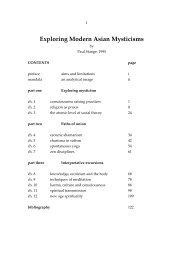Javanese Mystical and Marxist Dialectics - Paul Stange
Javanese Mystical and Marxist Dialectics - Paul Stange
Javanese Mystical and Marxist Dialectics - Paul Stange
You also want an ePaper? Increase the reach of your titles
YUMPU automatically turns print PDFs into web optimized ePapers that Google loves.
would have its own shrine marking the point of interaction. The whole economic <strong>and</strong>ritual process rested on communal religious obligations. The core ritual, theselametan, has been a celebration of neighborhood solidarity <strong>and</strong> spirit worship.According to GeertzThe whole momentum of the <strong>Javanese</strong> ritual system is supposed to carry onethrough grief without severe emotional disturbance. 15This emphasis on control over emotions is part of the overall connection betweenelite alus values <strong>and</strong> peasant society. The main vehicle for the transmission of prijajivalues has been the wajang <strong>and</strong> the arts generally. 16The central themes of traditional wajang were the alus-kasar tension <strong>and</strong> the strivingfor rasa, inner control <strong>and</strong> peace, through the “appropriateness of thoughts asestablished by duties to caste <strong>and</strong> hierarchy.” 17 Anderson has gone on to probe therelationship between these themes of the wajang <strong>and</strong> the “tolerance” of the <strong>Javanese</strong>.The basic sources for wajang tales have been the classic Indian; epics, theMahabharata <strong>and</strong> Ramayana, but there has always been considerable addition <strong>and</strong>elaboration of local tales along with reference to current events. The dalang, a manwith a good deal of prestige, served not only as puppeteer <strong>and</strong> story-teller, but alsoas a source of esoteric mysticism <strong>and</strong> philosophy. While the wajang eventuallyabsorbed some Islamic ideas, it remained a fundamentally <strong>Javanese</strong> <strong>and</strong> Indianventure.The tolerance projected by the drama comes through in the plurality of acceptablemodels for behavior, a plurality contrary to Western <strong>and</strong> modern dichotomies ofgood <strong>and</strong> evil. Sanction came through the theater to all types of people at variouspositions of life <strong>and</strong> not just to a single ideal type. Along with this came the <strong>Javanese</strong>notions of existing states of life as an interplay of levels of reality. In the drama itselfthere is an interplay of levels: the Indian epics, local mythology, the dalang'sinterpolations, the leather puppets themselves, <strong>and</strong> the shadows cast on the screen.While each level had a concrete existence of its own <strong>and</strong> was independently evidentto the audience, no one level was a final statement on what is “really real”. Neitherthe format nor underlying philosophy suggested an absolute. As a result, the<strong>Javanese</strong> demonstrate considerable tolerance of ambiguity. As Anderson puts it




